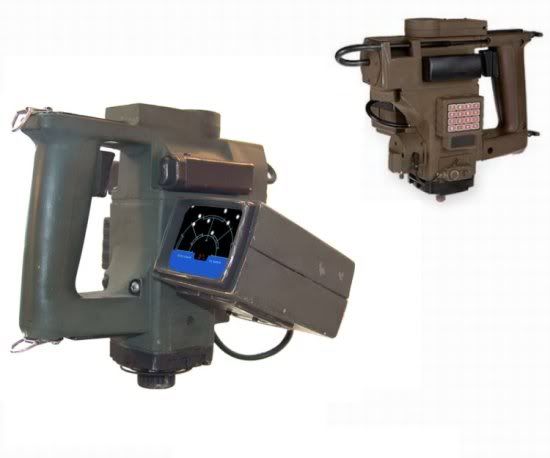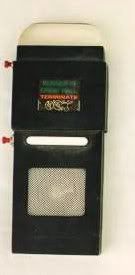Colonial Military Multi Scanner
The newest portable scanner in the Colonial military’s inventory. Able to detect and analyze chemical/material substances, biological samples and life readings, as well as energy/radiation sources. Only one function can be used at a time. Ranges vary on what the scanner is seeking, the concentration of the target, surroundings, environment and type of sweep. Using the scanner requires an Electronic Operations (Sensor) skill. Interpreting the data, beyond basic readings, is up to the operator and require knowledge in the appropriate fields (Geology, metallurgy, biology, etc) though a mini computer can be linked to the scanner for enhanced functions.
Chemical/Material Scans
Capable of locating designated material types or analysing the chemical compound of a selected substance.
Analysis Function.
Range 5 maxims (about 15 feet) line of sight is mandatory. Being able to touch the substance enhances the scanner’s ability.
The scanner can determine the general percentages of the chemical compounds making up the substance and can compare it to a list of known substances for a probable match. Can determine some properties of the substance, toxicity, volatility, explosiveness, magnetic properties, radiological qualities, crystalization structure, specific gravity, mass up to 1 megon (1 kilo ton) and atomic weight. A skilled operator, using the scanner and with knowledge in material sciences, can use this data to interpret if the material is artificial or natural, its age, stability and economic value (for example, ore and its viability of recovery.)
Locating Materials
The scanner, once keyed for the desired substance, can identify any and all sources in a 365 degree globe of the scanner. The range of effectiveness depends on the mass of the material, the amount and nature of the materials that may be blocking or covering the desired target and the nature of the material sought.
(Note, this is the setting for finding Cylons! Their design dampens energy readings so the Energy Scan is largely ineffective at ranges beyond a few maxims. They are not alive so the Bio Scan is useless as well.)
Mass of less then 1lb, range = 3 maxims (10 feet)
Mass of 1 to 5lbs, range = 5 maxims (15 feet)
Mass of 6 to 25lbs, range = 16 maxims (50 feet)
Mass of 25 to 100lbs, range = 32 maxims (100 feet)
Mass of 100 to 500lbs, range = 1 hectar (330 feet) (normal category for a Cylon)
Mass of 500lbs to 1 ton, range = 3 hectar (1,000 feet)
Mass of 1 to to 10 tons, range = 1 matzor (3,300 feet)
Mass of 10 tons to 1 megon(kiloton,) range = 2 matzor (6,600 feet)
For masses in excess of 1 megon the range is a bit over 5 matzor (about 16,500 feet, 3 miles)
Bio Scans
The scanner detects the chemical compounds most commonly associated with life forms. The range at which it can detect life forms depends on the size of the subject and the environment. Known life forms can generally be identified, though species and genetic variation allow for an element of error. Absolute identification requires medical grade equipment. Individuals within a species or population cannot be distinguished by this scanner.
Life Form/Bio Mass
Bacterial/viral/microscopic. Range is 1 maxim (3 feet) All the scanner can do is confirm the presence or absence of such organisms. It cannot distinguish between a ‘normal’ biomass and an infected one. Anything more detailed requires medical scanners and similar specialized equipment.
Tiny organism, Bio Mass of less then 1 ounce (insect size, blade of grass, small plant) range = 3 maxims (10 feet)
Very Small organism, Bio Mass 1 ounce to 1lb (mice, voles, squirrels, bunnies, mid size plant, etc), range = 5 maxims (15 feet)
Small organism, Bio Mass 1 to 10lbs (infant, house cat, small sapling, etc) range = 10 maxims (30 feet)
Average organism, Bio Mass 10 to 50lbs (toddler, average dog, young tree or shrub) range = 20 maxims (60 feet)
Mid sized organism, Bio Mass 50 to 100lbs (child, large dog, big bush) range = 50 maxims (150 feet)
Large organism, Bio Mass 100 to 200lbs (adult human) range = 100 maxims (300 feet)
Very Large organism, Bio Mass 200 to 500lbs (lion, tiger) range = 200 maxims (600 feet)
Extremely Large organism, Bio Mass 500 to 1,000lbs (big bear, small cow) range = 500 maxims (1,500 feet)
BIG organism, Bio Mass 1,000 to 6,000lbs (horse, bull, small whale) range = 1,000 maxims (3,000 feet)
HUGE organism, Bio Mass 6,000 to 20,000lbs (elephant, whale, dinosaur, big tree) range = 2,000 maxims (6,000 feet)
Uh Ohh…. Bio Mass in excess of 20,000lbs (start running) range = 4,000 maxims (12,000 feet)
Energy Scans
The scanner can be set to detect energy and power sources. These can include power cells, generators, energizers, power plants, running motors, nuclear or radioactive material, microwave or radio wave emissions, thermal sources, visible light, magnetic fields, x-ray, gamma ray, neutrinos, alpha rays and most other ‘exotic’ energy sources and manifestations. The range depends on the source and environmental issues like shielding substances and the presence of more powerful energy sources then the target. (Finding a flashlight battery next to a nuclear reactor would be very difficult.)
If a target is in the shadow of a more powerful energy source the range at which it can be detected, and the probability of being noticed, is reduced by 10% for every 10x bigger the shadow source is then the target.
Power Source and range
Power Cells
AA cell (smallest) range = 1 maxim (3 feet)
A cell, range = 3 maxim (10 feet)
B cell, range = 10 maxim (30 feet)
C cell, range = 30 maxim (100 feet)
D cell, range = 100 maxim (300 feet)
E cell (largest) range = 300 maxim (900 feet)
Generator/Energizer
1to 10 KWH = 500 maxims (1,500 feet)
10 to 100 KWH = 1,000 maxims (3,000 feet)
100 to 1,000 KWH = 2, 000 maxims (6,000 feet)
1,000 to 10,000 KWH = 4,000 maxims (12,000 feet)
10,000 up to 1 MWH = 8,000 maxims (24,000 feet)
1 MWH to 10 MWH = 16,000 maxims (50,000 feet, 10 miles)
10 MWH to 100 MWH = 32,000 maxims (100,000 feet, 20 miles)
100 MWH and up = 100,000 maxims (300,000 feet, 60 miles) can ‘see’ a ship in low orbit
Transmitters
Energy scans can detect radio, microwaves and similar transmissions out to the range of the transmitter. It cannot interpret or ‘receive’ the signal like a radio, but it can give direction and strength readings.
Radiation, Xrays etc….
The strength of the source, measured in Radions, and the type of radiation (Xray, gamma ray etc) and the amount and types of shielding between the source and the scanner will all have a bearing on this. In general the following applies.
Extremely Low Level, .001 Radions/centar = 10 maxims (30 feet)
Very Low Level, up to .01 Radions/centar = 30 maxims (100 feet)
Low Level, up to .1 Radions/centar = 60 maxims (200 feet)
Nominal Level, up to 1 Radions/centar = 90 maxims (300 feet)
Moderate Level, up to 2 Radions/centar = 200 maxims (700 feet)
Hazardous Level, up to 5 Radions/centar = 1,000 maxims (3,000 feet)
Dangerous Level, up to 10 Radions/centar = 10,000 maxims (30,000 feet)
Lethal Level, over 10 Radions/centar = 100,000 maxims (300,000 feet)
(Note: a 1 megaton fission bomb generates 6,600 radions in a single pulse.)
Thermal Detection
This presumes little or no insulation or shielding. Powerful thermal sources blank out weak ones.
Electrical equipment and their power cells will generate a heat source simply by being turned on or in ‘standby’ mode. Any equipment powered by an A or AA cell does not produce a measurable signal until it is operated. Larger cells and their equipment produce a thermal signal. Actually using the device may produce considerably larger thermal signals!
B cell, range = 3 maxim (10 feet)
C cell, range = 10 maxim (30 feet)
D cell, range = 20 maxim (60 feet)
E cell, range = 40 maxim (120 feet)
Small flashlight, pocket heater, mini computer, languatron etc = 80 maxim (250 feet)
Laser, Blaster, campfire etc = 500 maxims (1,500 feet)
Ground vehicle motor, etc = 1,000 maxims (3,000 feet)
General Scan Modifiers
Electro magnetic fields can reduce the efficiency of the scans. Normal ones, such as produced naturally by most planets, have no effect. Moderate ones, such as what is found in most parts of a ship or installation with power systems, reduce range by 25%. Strong ones, such as found in engine rooms, near power plants etc, reduce range by 50%. (See notes on Energy Scans.)
Radiation. Normal background radiation is adjusted for by the scanner. Hot spots, such as nuclear warheads, atomic power plants, powerful isotopes, masses of radioactive material etc, can fog or cloud scans of all kinds in the area. (See notes on Energy Scans.)
Loose top soil, sand, gravel, dirt will reduce the range 10% for every 50 feet of thickness.
Bed rock, solid rock walls etc, will reduce the range 20% for every 50 feet of thickness.
Normal cabin bulkheads (building walls) are no impediment to the scanner, but ship hulls and primary bulkheads (Structural walls built of materials similar to the hull and designed to isolate sections of deck in the event of catastrophic decompression.) along with deck materials (between levels) will block the scanner, reducing range by 50% for each foot of thickness. (A typical civilian ship has a hull between 3 and 4 feet in thickness. Structural bulkheads are usually 2 feet in thickness.)
Scan Patterns are either straight ahead, which has a 60 degree arc and uses listed ranges. Or omni directional, which is 360 degrees and ranges are divided by 5.
Colonial Military Multi Scanner

Security Scanner
Though primarily employed by the Security Service, this is a military device and is also employed by Colonial Military Police and similar units.
Used by Security officers when seeking a particular suspect. DNA and Bio/Genetic data on the suspect is downloaded to the sensor unit. (Every individual in the Fleet has his or her genetic data stored in the Life Service Gene Bank.) The scanner has a range of 30 maxims (about 100 feet) if the suspect is in range of the scanner, the device will provide a distance and bearing to the suspect.
Normal cabin bulkheads are no impediment to the scanner, but ship hulls and primary bulkheads (Structural walls built of materials similar to the hull and designed to isolate sections of deck in the event of catastrophic decompression.) along with deck materials (between levels) will block the scanner. Additionally, high energy sources and radiation will disrupt the signal.
Security Scanner
